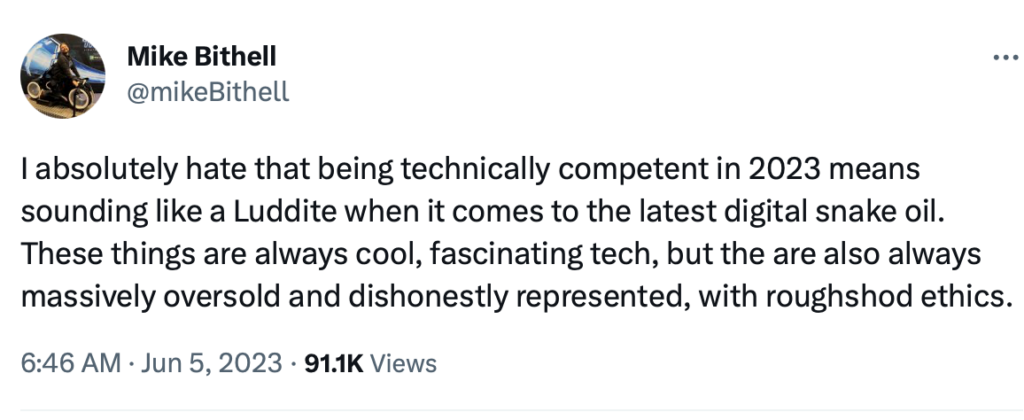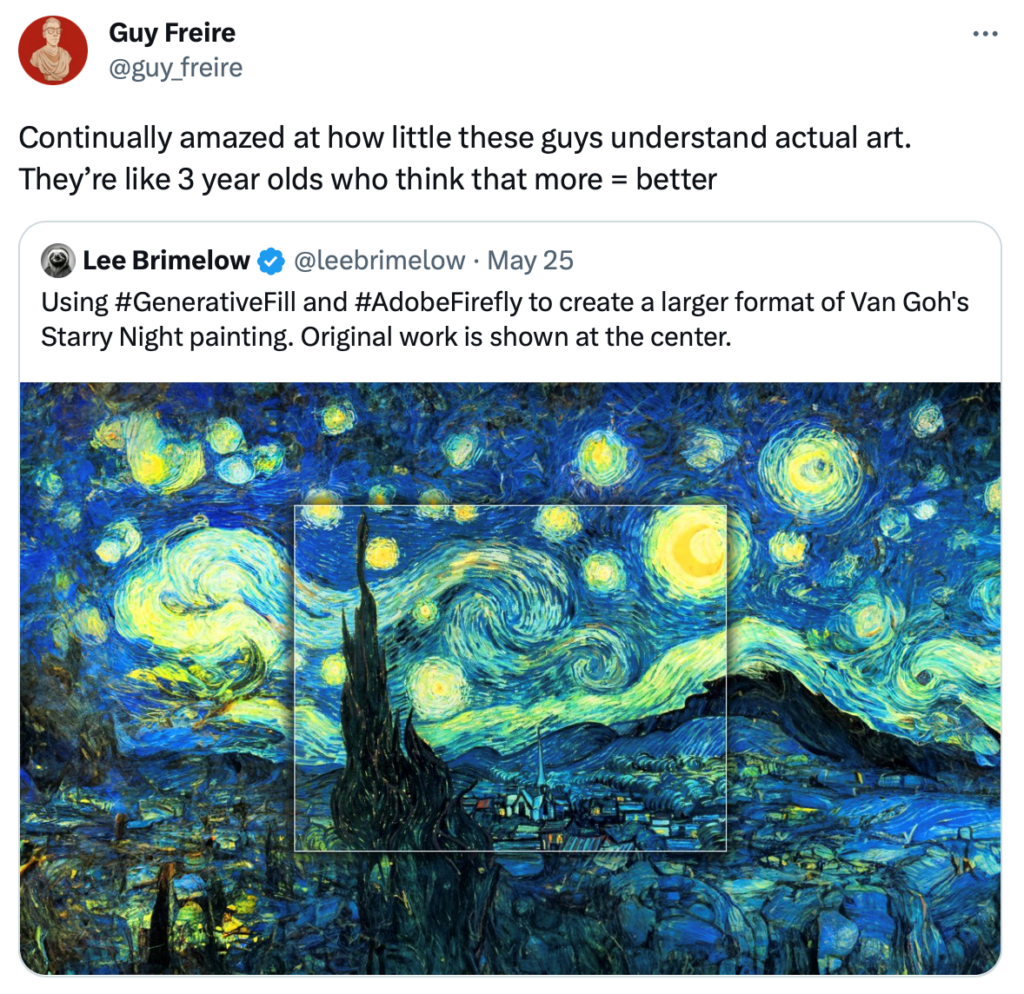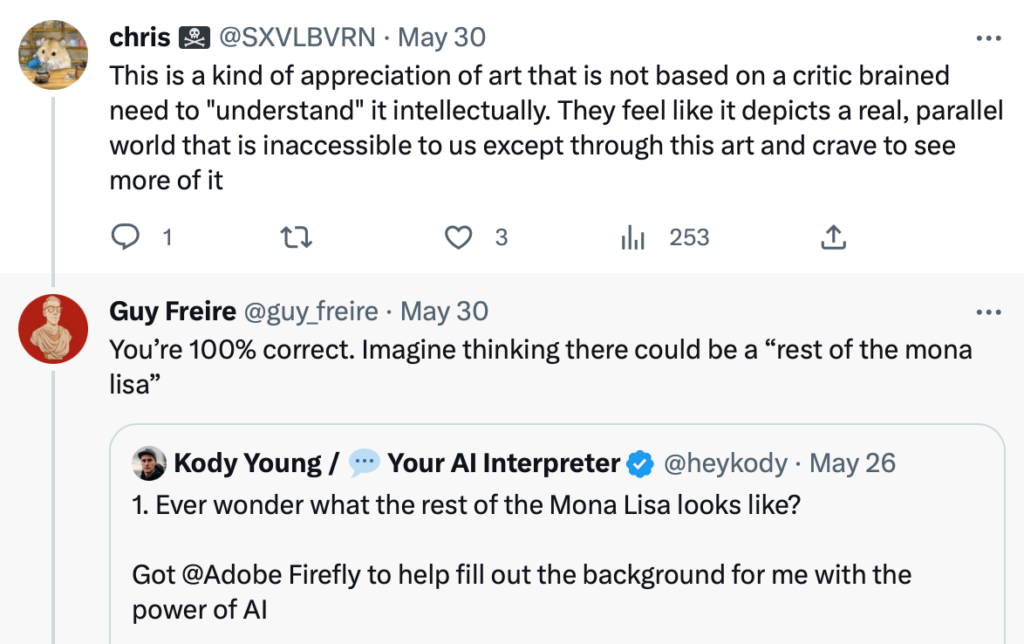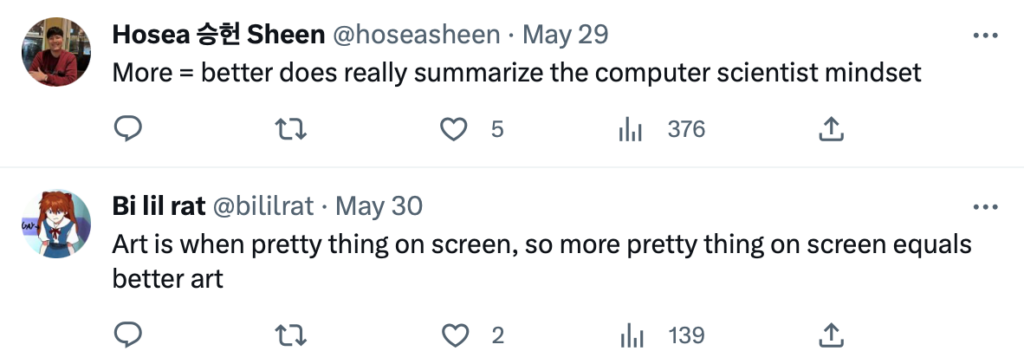I’m an admitted curmudgeon. Charitably, I suppose you could call me a skeptic. It ultimately leads to the same point: The addition of AI to an already complicated marketing landscape does not excite me. I’m not immediately won over by another shiny object. What’s worse, this one threatens to replace me and much of what I’ve spent a career mastering with a thin gruel made up of mashed-up years-old copy. What comes out is never going to be cited. No original thought producers will ever be given credit. It’s simply stolen, regurgitated content.
I’ve always disliked the use of “content” as a catch-all for creative work. It devalues the artistry that goes into filmmaking, graphic design, audio production, etc.
That said, “content” is the perfect description for what AI spits out.
It’s filler.
Typically, colleagues will tell me they’re using AI to get started when they don’t have any good ideas, or to provide an outline that they can add their own touch to later. It’s been applied to copy where minimal creative input is required.
If you need to use AI to write it, maybe consider not writing it? If you’re writing a dry, informational post about an event date, what can you add to give it life? The robots definitely can’t “punch it up” at this point.
The internet has plenty of useless copy. A dull post is likely to prompt very little engagement, anyway. If there’s nothing exciting or inspiring about what you’re going to write, why write it? Write something better! Rethink the assignment! Damn the man! Power to the poets!
But, we’re often tasked with filling content calendars and I can see how the siren song of AI might lure you in if you’re a little burnt-out and the well is dry.
It’s a brainstorming tool, a potential springboard to better ideas.
Fine.
I’ve never seen it produce something truly surprising and insightful, but that’s not the point.
So, what IS it good at? What possible reasons might we haters have for tolerating (if not lovingly embracing) our new AI overlords?
I asked ChatGPT to write a blog for a marketing agency about why a hater should be excited about the use of AI. It’s only fair to offer it a chance to defend itself.
Welcome to The Hater’s Guide to Using AI! If you’re one of those people who believe that robots will take over the world or that machines will render humans obsolete, then this guide is for you. Here, we’ll show you how to use AI, even if you hate it, and how it can be beneficial to your life.
Firstly, let’s define what AI is. Artificial intelligence, or AI, refers to computer systems that can perform tasks that typically require human intelligence, such as speech recognition, decision-making, and language translation. There are many different types of AI, including machine learning, natural language processing, and computer vision.
Now that we have that out of the way, let’s get to the guide. Here are some tips for using AI, even if you’re a hater:
1. Embrace the fact that AI is here to stay. Whether you like it or not, AI is becoming more prevalent in our daily lives. It’s in our phones, our cars, and our homes. Instead of fighting it, try to understand it and use it to your advantage.
2. Use AI for tasks that you don’t enjoy doing. Hate doing laundry or cleaning the house? There are AI-powered robots that can do those tasks for you. Hate scheduling appointments? There are AI-powered personal assistants that can do that too.
3. Don’t believe everything you hear about AI. Yes, there are some negative stories out there about robots going rogue or AI taking over jobs. However, these stories are often sensationalized and not reflective of the reality of AI. Educate yourself on the technology and make your own informed decisions.
4. Be aware of the biases in AI. Like humans, AI can be biased. This can happen if the data used to train the AI is biased or if the AI is designed in a way that reflects certain biases. Be aware of these biases and advocate for more diversity and inclusivity in the development of AI.
5. Use AI to learn new things. There are AI-powered apps and platforms that can help you learn a new language, play an instrument, or even learn to code. Take advantage of these tools to expand your knowledge and skills.
In conclusion, AI is not something to be feared or hated. It’s a tool that can make our lives easier and more efficient. By understanding and embracing AI, even if you’re a hater, you can take advantage of its benefits and improve your quality of life.
One thing’s for sure – it isn’t going away.
And, yes, I’m looking at AI through the narrow lens of marketing and creative professions. We should differentiate to give Roomba the credit it deserves in prolonging the intervals of time between me pulling the real vacuum cleaner out of the closet and taking it for a waltz (which, ultimately, yields superior results).
Focusing on creative pursuits, some recent social media posts come to mind:

I don’t like to sound alarmist, but it’s just…not that great. Any good tool simplifies something; here, AI is not simplifying writing or design in a way that makes anything that comes out better. It’s also “borrowing” existing human-made work, which is a huge ethical issue for me.
As a creative professional myself, I believe in the power of empathy and authenticity in marketing. We should make the organic, artisanal work so good, so obviously impossible for machines to replicate in any convincing way, that AI just isn’t a viable replacement.
Our jobs are safe. As for embracing AI, it’s another potential tool in your kit. Maybe it will make your life easier? Maybe it can generate useful ideas that spark something even better when you add your personal touch?
Use it if you want, understand it and evaluate new developments, but know that what comes out is going to be soulless.

Have you ever worked for a mediocre boss? Try as you might, succeed as you may in the face of their inability to understand the value your creative and strategic input adds, everything will lead to the final call being in the hands of someone who, at best, is maybe okay at the shell game that is managing a bottom line.
I see AI as interesting, but less-than. It isn’t fully-baked. Currently, you can get something resembling usable copy, but you’ll still have to massage it to add a human touch. The robots simply aren’t there…yet.
It’s a plastic imitation.
In the eyes of the mediocre, however, maybe plastic and close-enough is fine? They don’t really value art. They don’t really care about real human connection. They care about money. They like a happy Board of Directors.
Buzzwords have more capital in their circles.



“How about that AI, huh?” asks Mediocre Boss 1.
“Yes! Such an interesting opportunity to synergize the paradigms and offboard some KPI” or some such, replies Mediocre Boss 2.
They don’t care if a robot gurgles out a C+ social media post – it all looks the same to them, anyway!
Our work, input, and vision have meaning and value.
I’ve used automation to save time in my career. Digital editing software makes so many parts of the process simpler. As a Promotions Producer in broadcast television for many years, I happily used automation to add airtimes to tune-in promos with graphics and announcer voice. So much time was saved not tagging, exporting, and re-ingesting multiple versions of promos for just one program that I was able to use the time for far more creative and interesting projects.
Tools are good if they enable you to do more of the things you want to do.
As makers, our ability to elevate an idea into evocative and inspiring copy and multimedia elements is what continues to set us apart. Our ability to choose emotion and to embrace something technically imperfect leads to unexpected results.
So, use AI in any way that makes your job better and allows you to make more art. Machines can’t do that – and art is what gets results that achieve your goals and make you proud.
In time, the technology may improve at mimicking the human mind.
For now, there’s still no replacement for the real deal.